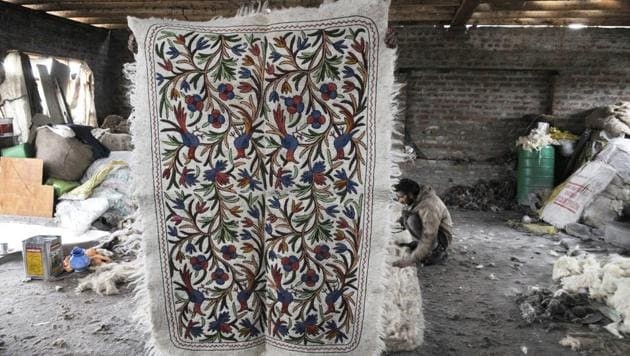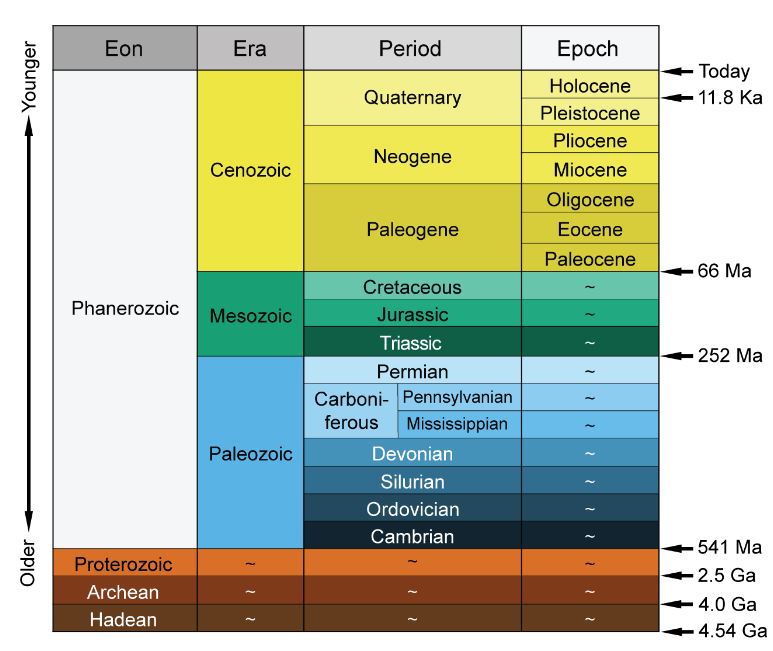Namda Art
The Namda craft of Kashmir is being successfully revived under a Skill India’s Pilot Project as part of the Pradhan Mantri Kaushal Vikas Yojana (PMKVY).
- Namda is a rug (carpet) made of sheep wool in Jammu and Kashmir.
- It will be produced through felting technique instead of normal weaving process.

Felting is the process of producing a textile or fabric by combining and compressing the loose fibers, wool or hair.
- It originates in the 11th century when Akbar ordered for a suitable coverage for his horse who was affected by biting cold.
- Namda is usually a sandwich of many layers of wool flattened over each other.
- After a layer is spread, it is sprinkled homogeneously with water and pressed with a tool known as ‘pinjra’ (woven willow wicker).
- The process of making Namda involves various steps such as carding, creating the border, the creation of a layer, sprinkling soap solution, rolling the Namda, drying and finally, the Aari work.
- Despite the exquisite beauty of Namda, it is threatened due to various factors including:
- Fewer skilled craftsmen
- Modernization of carpets
- Emergence of cheap imitations
- Less interested younger generations
Namda Project
- Aim – To train nearly 2,200 candidates from across 6 districts of the state.
- Ministry - Ministry of Skill Development and Entrepreneurship
- The scheme is envisaged under Pradhan Mantri Kaushal Vikas Yojana (PMKVY).
- It is an example of the public-private partnership (PPP) model and it is being implemented in collaboration with local industry partners.
References
- PIB | Skill India project successfully revives the dying Namda Art
- The Hindustan Times | Namda - Felted craft of Kashmir
- The Hindustan Times | Discovering Namda
Pakkasuran Malai
Conservationists have criticized the Tamil Nadu Tourism Development Corporation’s (TTDCs) plan to open up the eco-sensitive area surrounding Pakkasuran Malai, a hill in Nilgiri region to tourism.
- Pakkasuran Malai is a mountain also called as Hullikal Drug.
- It is situated in coonoor, Nilgiri Mountains of Tamil Nadu.
- It is a biodiversity hotspot primarily composed of rocks and grasslands.
- Droog Fort is a historic fort on the peak of Pakkasuran Malai and it has significant historical, cultural and religious values and qualifies as a sacred grove.
Sacred groves are patches of primeval forest that some rural communities protect as abodes of deities and it helps in the protection of many rare, threatened and endemic species of plants and animals in the area.
|
Species in Pakkasuran Malai
|
|
- Gunther’s burrowing snake (Plecturus guentheri)
- Valeriana leschenaultii, an endemic species (Critically Endangered)
- Nesting site for the Shaheen falcon (Falco peregrinus peregrinator)
|
- Nilgiri martens
- Mouse deer
- Indian gaurs
- Barking deer
- Leopards
- Sloth bears
- Indian giant flying squirrels
- Indian giant squirrels
- Brown palm civets
- Indian crested porcupines
|
Reference
The Hindu | Pakkasuran Malai
Kui Language
The state cabinet of Odisha, recently approved a proposal to recommend the inclusion of the Kui language in the 8th schedule of the Constitution of India.
- Kui is also known as Kandh, Khondi, Khond, Khondo, Kanda, Kodu, Kodulu, Kuinga, Kuy.
- It is a South-Eastern Dravidian language spoken by the Khond tribes of Odissa.
- It is mostly spoken in Odisha, and written in the Odia script.
- It is closely related to the Gondi and Kuvi languages.
- According to UNESCO, the Kui language status is potentially vulnerable.
- Significance - Inclusion of Kui in the 8th schedule will help in the preservation, promotion and propagation of the language and culture because there are 7 lakh Kui-speaking indigenous people in Odisha.
8th Schedule
- The 8th Schedule of the Indian Constitution consists of 22 languages.
- Of these languages, 14 were initially included in the Constitution.
- Sindhi language was added in 1967 while Konkani, Manipuri and Nepali were included in 1992.
- Subsequently Bodo, Dogri, Maithili and Santhali were added in 2004.
- English is not among the 22 languages in the 8th Schedule and it is one of the 99 non-scheduled languages.
Reference
New Indian Express | Kui language inclusion in 8th schedule
Anthropocene epoch
Geologists have said that sediments at Crawford Lake in Canada’s Ontario have provided evidence that the beginning of the Anthropocene epoch is between 1950 and 1954.
- The Anthropocene epoch as a term was first coined by Nobel Prize-winning chemist Paul Crutzen and biology professor Eugene Stoermer in 2000.
- It is an unofficial unit of geologic time that denotes the most recent period in which the Earth’s ecosystem has gone through radical changes due to human impact, especially since the onset of the Industrial Revolution.
- There are numerous phenomena associated with this epoch, such as global warming, sea-level rise, ocean acidification, mass-scale soil erosion, the advent of heat waves, deterioration of the biosphere.
- Anthropocene, the term has not been formally adopted by the International Union of Geological Sciences (IUGS), the international organization that names and defines epochs.
Crawford Lake
- Crawford Lake is a small, deep lake within a protected conservation area in Southern Ontario, Canada as part of a UNESCO Biosphere Reserve.
- Topography - The lake is situated in a karstic limestone landscape and fills a sinkhole created by the dissolution of underground rock.
- Meromictic Lake - Because of the lake’s great depth (24 meters) relative to its surface area it is known as a meromictic lake.
- It refers to a permanently stratified body of water where the bottom layer of water does not mix with the upper layers because of differences in chemical composition.
- Crawford Lake and its layers of sediment preserved the annual impact of human activities on the Earth’s soil, atmosphere and biology.
Earth’s Geological Time
- The planet’s geological time scale is divided into 5 broad categories - eons, eras, periods, epochs, and ages (Larger to smaller).
- While eon is the broadest category of geological time, age is the smallest category.
- Each of these categories is further divided into sub-categories.
- These units are classified based on Earth’s rock layers, or strata, and the fossils found within them.
- The present geological time - Phanerozoic eon, Cenozoic era, Quaternary period, Holocene epoch and the Meghalayan age.

References
1. The Indian Express | Anthropocene epoch
2. Anthropocene Curriculum | Crawford lake, Canada
3. National Geographic | Anthropocene
Tire Particulate Pollution
A recent study says that the tires and its particulate pollution causes harmful effects to environment and human health.
- Findings - The study revealed that tires produce more than 1 trillion ultrafine particles for each kilometre driven, meaning particles smaller than 23 nanometres, that are hard to measure.
- According to a report shared by Emissions Analytics, a single car sheds 4 kilograms of tire particles weight per year, on average.
- In 2021, 52% of all the small particle pollution from road transport came from tyre and brake wear, plus a further 24% from abrasion of roads and their paint markings.
- Impacts - The tire particles pollute air, water and soil and contain a wide range of toxic organic compounds, including known carcinogens.
- These are of special concern to health, as their size means they can enter organs via the bloodstream.
- Also, tires contain volatile organic compounds (VOCs), which are hazardous to human health, and react in the atmosphere to create smog.
- The particulate itself washes into waterways and has been found to be a significant source of oceanic microplastics.
- Salmon deaths - A specific chemical used in tyres has been linked to salmon deaths in the US, and California has proposed a ban.
- 6PPD – 6PPD is an organic chemical widely used as stabilising additive in rubbers.
- 6PPD is water-soluble, so it is carried off of roads by rain and washed into rivers and oceans where it has been linked to mass salmon and trout die-offs.
- 6PPD is absorbed by edible plants like lettuce and that the compound can be found in human urine.
References
1. The Indian Express | Electric vehicle tires- lesser-known pollution
2. The Guardian | Car tires produce vastly more particle pollution
